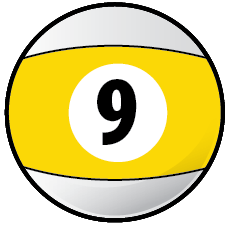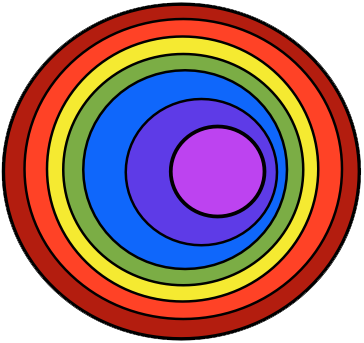Nutshell ~ horizontal scales ~ 'groups of pitches.' All throughout this e-book the idea of a 'group of pitches' comes along. It's just a way of thinking, a theory perspective. To visualize the notes in a scale as a sort of string of pearls, each one unique in its contributions to the whole group. We slide 'group of pitches' in with the more common melody making terms such as; scales, modes and even tone row, and easily expand a bit further into the arpeggios and chords too. And as these are the main melodic resources for creating musical art, we add this idea of a 'group of pitches' for two reasons. |
First, is that a 'group' can also be thought of as a closed group of elements, so there's a sense of a looping and perfect closure to the chosen notes. In this looping there's both a collective and individual strengthening of the pitches. Played off one another over a harmony color, we develop a sense of the gravitations to a central, tonic pitch, defining a key center. The old adage that the 'whole is greater than the sum of its parts' is way true in music too. |
And second, a complete group of pitches and its name identifier become the basis for describing the emotional character of the story of a song; major, minor, Dorian, quartile (chords). So 'groups' becomes a way to position music's emotional 'colors' on a palette for mixing. And as we refashion our perception of the the colors over the years their mixing evolves. |
If this all sounds obvious to you, splittin' hairs, then cool. The only caveat being that if we think and practice scales as scales ... our melodic ideas just might end up sounding like well ... 'scales.' And how musical sounding are scales ...? Right, depends on who's playing them :) So we combine 'groups' with 'scales' philosophically; shed 'scales' as necessary for making chops and think 'groups' as an assist in keeping our chops ever melodic. And while there's a super wide selection of groups to choose from, most of what we do in Americana musics is from the essential three groups; pentatonic, diatonic and the blues, each now set in color stones whose pitches come to us from the ancient times. And if u've another fave in addition, 'groups' philosophy is for all :) |
A definition of a scale. A succession of notes, normally either a whole tone or a half tone apart, arranged in ascending or descending order. |
A definition of a group of pitches. A predefined set of pitches that clearly define a musical color and emotion, a set of pitches that functions as its own closed set of pitches with its own diatonic center, thus its pitches can be in any order and still retain its artistic properties. |
Author's note. Three essential theory elements that go into defining what any group of pitches will sound like; overall major or minor as defined by its 3rd scale degree. And same for the 7th; a major or minor 7th interval as measured from the root note. A third aspect to master is the location of the half steps within any 'scale formula' needed as these play a prominent role in composing; including various suspensions and the natural play of tension and release in the music as it personifies in sound the emotional story of a song. |
Americana pitches. In creating the necessary pitches to make the various Americana musics, we really need two sets of pitches. One set of very finely tuned pitches to make both melody and chords. And one loosely tuned set to slip the blue note hues into any melodies. When we run these together in making music, we've the potential to play diatonic melodies, supported by diatonic chords and also bring a blues hue nuance anywhere along the way to create our indigenous blue's rub. Both 'hue' and 'rub' are original Americana musical inventions that with practice become aurally unmistakable, when we purposely 'hue or rub' and weave these two uniquely tuned sets of pitches together. |
The theory which follows doesn't go very deep exploring the 'rub' just above. And luckily, it doesn't really have to in a book :) So what follows is the basic theory of the pitches. Very neat and all. Closed loops that evolve, pitch by pitch, into new and bigger loops with expanded possibilities. That said, when a chance arrives to rub in some blue's hue, we do. For there's just a couple of old time tricks to it really, and there's just a few blue notes, at least when starting out to understand the pitches, so manageable. Then off on a lifetime of musical joy by discovering how our bothers and sisters put their own blue's hue tricks into play. |
What's next. In the following discussions we extract our core melodic loops from the 12 pitch chromatic scale. To build up the basic groups of pitches, the various scales and modes, from which we create our melodies. These groups will then become the arpeggios, some of which we then stack up and sound together making the chords. |
Three main elements + time. We theorists form our pitches into the scales, arpeggios and chords that we motorize through time to make our music. This book's core discussion of the Americana scales follows below. Click off for the arpeggios, chords and time discussions. |
Additive evolutions. Woven through all of our discussions is the theoretical and philosophical basis of a simple numbering of the elements. That any component can be 'style defined' by the number of actual pitches. Example, we group three different notes to make triads. Triads are the chords for folk musics. Blues needs a b7, so we add one new pitch, and now have four different pitches in our chords. '7th' chords to play blues. Simple. The chords with five different pitches? Leaning to jazz probably and to jazz things up. |
With grouping pitches for creating melodies for songs, we start with five pitches for making major, happy melodies our kids. We then flip these to minor and add one pitch for Americana blues melodies. Then flip it back over to major and add a pitch for gospel styled melodies. At seven pitches our group's magics kabooms in multiple ways. And from there? Just adding new pitches one by one up to 12, for making country, rock and pop melody lines, and then jazzing them all up. |
Number of and location of the half steps. Locating where the half steps live in any group of pitches just might be the easiest way to capture each group's unique character. And does the number of half steps in a group, usually there's two, help shape and tell of its tonal gravity? It surely can. And is the tonal gravity pull between pitches a half step apart like the pull in the timing of swing ? Read on and discover :) |
Advancing theorist. For the advancing theorist reading here, that knows about scales, there's really just the one idea for 'groups of pitches.' Simply that our 'groups of pitches' today are the perfectly closed loops of pitches from which we create our melodic ideas; melody, harmony, improvisations etc. Experienced players know the sounds of scales. Creating an idea from a 'group', while simply rhetoric for some, becomes perspective for another, that reshapes lines to sound 'less scale like' and more 'storyline melodies.' Subbing for the term 'scale' to a certain extent, a 'group' also includes the multifaceted, diatonic properties that each pitch in a 'scale' brings to the conversation of the group as a whole. Their modes? Yep. |
Many solid properties including modes, shades of major / minor, arpeggios, colortones, 'parent scales' for phrases, intervals, sequences, soloing through and or over the changes, revolve around this 'group' idea. Our chosen group creates what is diatonic, thus establishing the initial boundaries of a select group of pitches. Surely a stabilizing perspective for venturing on. |
History ~ theory overview. We modernés of today know of the ancient music potentials by way of that cave bear flute found back in 1995 in Slovenia. What we do not know of course is what melodies got played. Oh well, we can't know everything. We can know our Americana roots, the pitches used and the general idea of the music being created. And once we get to the post 'Edison' days, we're really kind of good to go in knowing of the music through audio recordings. |
Overview: Having created an overview of our 12 pitch musical resource in the silent architecture of music and then examined the interval loops, then added the Yin / Yang balance of major and minor, all with a dash of historical spice, mathematics and whatever else came to mind, we can now begin to comb out the more defined groups of pitches from which we create the Americana sounds we love. So as with our loops study, where we started with our smallest intervals, we'll create and sequence our melodic groups here by starting small and evolving pitch by pitch. |
Of course it is no coincidence that our smallest grouping of musical pitches may also live at the historical core of all our music. And while there are other possible groups, using additional intervals in the mix, it turns out that in our everyday musical lives just one interval grouping or formula has created the bulk of our melodic material. This of course is the seven pitch diatonic major scale / Ionian mode / natural minor / Aeolian mode partnership. For me, this group provides half the Yin / Yang balance and basis of our local musical universal. The other half? Why the blues and its blue notes of course :) |
Tuning magic. And while the melodic importance of the aforementioned seven pitch major scale / grouping in our AmerAfroEuroLatin music might never be overstated, we should add into the mix now about how we modernists tune these pitches today. That our modern tuning system is what creates our entire pitch resource. For in today's modern tuning system, all of our groups / scales, their modes, arpeggios and chords, are equally project-able from each of the 12 pitches, thanks to the mathematics of equal temper tuning. Without which, much of the intune chords and borrowing of interesting puzzle pieces, from multiple if not all of our key centers, begins to go away. |
So if we get all of our melody and all of our chords from these ancient groups, no wonder they are still around eh? What about the blues? I knew you'd ask that. As we'll soon see, the blue notes / melodies are pure core Americana pitches too. That we find the blue colors woven into nearly every nook and cranny of our myriad of different styles and sounds, makes them all the more difficult to theorize about. We'll theoretically find them in the following discussion sandwiched in between the organic evolution of our five note minor group into a six for the blues, before adding one more for our grouping of seven. Sort of a missing link? Maybe. Do read on and discover their theory and then just decide for yourself where to place them in your own understanding of the musics. |
~ five ( penta ) ancient pitches ( tones ) ~ |
Pentatonic ~ five note group of all good pitches. At the historical and theoretical core of the Americana melodic sounds we find the five pitch group commonly referred to as the pentatonic scale. Found historically by musicologists in many folk indigenous cultures the world over, the melodies of our own Native Americans, which is the 'Amer' part of our AmerAfroEuroLatin musics, have cherished this group of pitches all along now. And it just turns out that all us 'Amer' improvising musicians love these pentatonic groupings too; found deep in the blues roots of our palette of musical colors. 'All good pitches' as players often say. |
In theory, these groups of five pitches build up with three whole steps, which creates its major 3rd quality, and two minor 3rd leaps, for the minor colors. In shifting these steps and leaps about, we get our variety of different groupings. And once any group is set, there's modal considerations within the loop. |
Initially we've two basic varieties of this grouping of five pitches; major and minor, can you hear the difference between the two? Major and minor? And know the theory of their colors? This first idea is in the major tonality. Remember this ditty from way back when? Thinking from the root pitch 'C.' Example 1. |
 |
"Shortnin' Bread." "Mama's little baby loves shortnin' shortnin' ..." Know this melody? The carefree, whimsical nature of this melody embodies one of the essential emotional character qualities of the major pentatonic group of pitches. When we hear melodies that create this sense of jaunty-ness and joy, really good chance they too are created from the pentatonic group of pitches. |
|
Songs for kids and beyond. With its handful of pitches and joyous nature, it is no surprise that we find this major pentatonic color creating musical tones for children, world music, rock, reggae and the pop styles. Why even those garden wind chimes, that bless us with their melodic strains, as freely wrought as the breeze that stirs them to life, are often the five notes of the pentatonic major group of pitches. |
|
Historically an essential grouping of pitches, we'll find pentatonic melodies in the early music cultures of China, Africa, our own Native American Indian cultures and that of the Celts and Scots of the British Isles. So its pitches have surely been with us for a very long time. |
|
Extracting the pitches. Thinking of the "Shortnin" melody just above, now that we have a wee bit of real art to examine, let's become the scientist and figure out what pitches and intervals the composer used, look for patterns and generate new avenues to explore, based on the theory of just this group of five ancient pitches. |
Music / math. We can do this by simply extracting the five different pitches of our melody from the twelve pitches of the chromatic scale. We then examine the distance between the pitches, their intervals, to create our pentatonic scale formula. Thinking major, from the root / tonic pitch 'C.' Example 1a. |
|
||||||||||||||||||||||||||||||||||||||||||||||||||||||||||||||||||||||
Examine the intervals. Thinking from our root pitch 'C', the major 2nd, major 3rd, perfect 5th and 6th intervals combine to create the overall coloring of the major pentatonic group of pitches. Easy enough huh? 1 2 3 5 6 ... no 4 or 7 yet ... Also, in measuring the intervals between the pitches, we also find two minor third intervals within the octave span. Hmm, what might that imply? And note also that there are no half steps in the formula yet, the basis interval of our chromatic scale and a 'definer' for others. |
Major pentatonic melodies. So what style of music can we create with these five core pitches? What triads or chords if any? The melodies would be along the lines of "Shortnin' above, so mostly jaunty songs for kids to sing along with easily. Surely some folk and gospel tunes. |
Want triads with these pitches? Working diatonically, so with just the five pitches, we get two triads; one major one minor. And these are the relative major and minor triads? Built up on One and Six ? Yes they are. Thinking from 'C' again, we get the 'C major and 'A' minor triads. The core of it all? Yea, and bigtime really. White keys on the piano, triads galore, at least through the styles up to when the blues comes along. All the chords happen real nice with the seven pitch diatonic scale. We'll get there soon enough even by just adding one pitch at a time. |
A Yin for every Yang Within the intervals in the major pentatonic scale scale formula we quickly discover the seeds for the minor tonality also. The minor third interval from 'A to C' is the key. Here are the letter name pitches, this time using the 'flat' accidentals in making up the chromatic group, our 'C' major pentatonic group now morphing into its relative minor, the 'A' minor pentatonic group. Super theory game changer here? Hope so. Ex. 2. |
|
||||||||||||||||||||||||||||||||||||||||||||||||||||||||||||||||||||||
Examine the intervals. The first leap of the minor third from our root pitch 'A' up to the minor 3rd 'C' gives away the tonality. Any group of pitches, arpeggios or chords, that uses this root / minor third interval basis, is always minor. Conversely, root / major 3rd is always major yes? So we can see the exact same letter pitches creating our two distinct tonalities. While we lose the 6th from the major group, we do gain a 7th in minor, which here is a whole step below or octave root note. This is the essential minor or blue 7th of the musics we call the blues. We can find it near anywhere through the Americana musics, where the blues has an influence. |
A place to start. For many musicians, the minor pentatonic grouping of pitches is the first pathway of our journey into the world of creating the sounds of Americana music. This next idea is the somewhat ancient European melody that becomes in 1800's Americana the newer "House Of The Rising Sun." Way later it becomes a #1 pop hit for The Animals in the mid 1960's. Find these pitches and express some built right-in core essential minor key coolness. Think 'A' minor and same scale shape as above. Here's what we can get with five pitches or so. Example 2a. |
|
 |
Classic line yes? Maybe play it real simple at first. Sing along with your notes and feel and find their power for you. Combine and strengthen up knowing exactly where to find the pitch you're hearing, then lean hard on these pitches with practiced confidence. Jazz it up by adding your own voice inflections on the pitches. Then find these inflections on your ax. Learn or write some new words, and testify they from the heart. All a very simply process, just 'sing the line, play the line.' Over and over till rote memorized and it becomes second nature, and then we can begin to think ahead. |
Author's note / a worthy tasking. These above melody notes of the minor pentatonic are the essential basis of our blues music and the blues scale, whose theory follows next. Strengthen up to be able to count it off and weave these five pitches through a few consecutive choruses of 12 bar blues and a true cornerstone is laid in your musical foundation. |
Original forms of minor pentatonic music. One key aspect of creating minor pentatonic / Native American melodies to remember is that a large number of voices usually sang the same melody line together, in unison. And while they probably strove to be in tune (?) or not as the case maybe, recordings and 'ear witness' accounts tell a different story. |
That the slightly 'in and out' of tune quality of multiple voices can be the spice to get the minor pentatonic pitches to further resonate together, heightening their powers. As artists, we'll often 'push the pitches around,' by bending and vibrato. Both change the pitch of the note. And as soon as we do, we feel these pitches charge up and begin to glow and vibrate, as we bump right into the power of the blue notes and their flavoring of most any Americana melody lines. Hint; with some 'love rub', the regular old 'in tune' blue 3rd just glows and glows. Try it, the sensation is unmistakable Americana blue :) |
This multiple voice / slight variable pitch quality is also found in through the early Americana gospel, the early revival blues singing. That this slightly 'out of tune' quality of pitch and intonation, created by many voices raised together in song, just might be an integral component of the spiritual allure and magic we seek when presenting this historical music today. |
Any triads / chords from these five pitches? Just the same two as from the major pentatonic group; a mostly 'A' minor 7th, with a sus 4 / 11. And a 'C' major 6 and 9 styled color, created by stacking perfect 4'ths above the root in this next example. Example 2b. |
 |
~ six pitches in minor ~ add a one pitch tritone ~ |
5 + 1 = 6 / minor. Our next group evolution evolves by adding one additional pitch to the five notes of the minor pentatonic color. Turns out that the pitch we need is the one that lives at the midpoint of our perfect octave span. Please examine the pitches. Example 3. |
|
|||||||||||||||||||||||||||||||||||||||||||||||||
Minor pentatonic five + one tritone = blues scale. By adding in this octave mid point pitch, also named an augmented 4th, diminished 5th or the tritone, the all important core blues scale, or grouping of pitches :) emerges. As the term itself implies, the tri-tone interval encompasses 'three tones,' which in this component is three whole steps. So six frets on one string? Yep, six. |
And add in some blue chromatic. With this tritone insertion, we also gain a bit of purely chromatic color into what was before a 'half step free zone' of the minor pentatonic group. Compare these groups of pitches over an 'A' minor, then blues over 'A7' chord vamp or click off to a 12 bar blues track and search for the coolness within this essential song form. Example 3a. |
 |
Here it clear? The tritone in the line? Cool. No? Just click again. Hard to over state how this one pitch, for blues leaning musics, in an instant brings the blue hue. |
If there was ever a historical home for the Americana sounds, surely this grouping of pitches would live there. We can easily research and find documentation of these default Americana blues colors in Ragtime (1890's), early jass (1900's), the blues (1910), Louis Armstrong's jazz (1920's onward), swing jazz (1930's), bebop (1940's) rock n' roll (1950's), blues / acid rock (1960's), electric blues and rock (1970's), disco (1980's ... well maybe not disco) but surely in James Brown's 1980's funk, Stevie Ray Vaughn blues (1990's) and even today in the _________ style (s) of this new millennia. And surely this essential color existed prior to our known written records. How far back is everyone's guess. Is there any real blues-less Americana musical era? |
|
Adding the tritone. This next idea simply bluesifies the minor pentatonic idea included just above. We 'blusify' by slipping in the tritone ( 'x' marks the spot for guitar ) into the line. Example 3b. |
 |
So very common. This tritone additive is very, very common in any of the blues infused rock and beyond Americana musical styles. Metalists might surely recognize this 'lifting' of an idea from what today has become a metal anthem originally done by British rockers back in '72.' Simply a timeless minor pentatonic idea with a dash of the tritone spice. |
|
A big tritone vamp. Getting momentarily away from things a bit with this next idea, we give the tritone color a bit more of the spotlight. Here's a potentially essential vamp idea, based the tritone interval. Something we might hear as a head arrangement, a vamp behind a soloist or an entrance of a intriguing type, yet perhaps comical character in theatrical spoofs. Count Basie and the Kansas City sounds of the late 30's and forward grooved hard on this sort of 'vamping tritone energy' and evolved the Americana jazz forevermore. Learn it here if need be. Example 3c. |
|
 |
Got a spot for this line ? Big tritone vamp :) |
Further digressions, a key theory element. Do you remember the interval formula for the pentatonic scale? And if there were any half step intervals in the formula? Well, there are none and the addition of the one pitch tritone here adds a half step interval, creating our blues group. For we now have chromatically filled in the whole step interval span between the 4th and 5th scale degrees. Hold onto this half step key as we're going to need it again momentarily. |
Back to the Blues. The blue notes go way deep of course in the Americana sounds. As such we can use these roots to great advantage in our music. One absolutely cool thing about the blues scale (notes), and in nearly any musical situation, is that they can be used as an 'anchor' to ground even the zaniest improvisations. That no matter how far out we go, a honking blue note can, and will bring us quickly home to our tonic pitch, key etc. (That is if everyone in the band hears it :) |
With roots so deep in our music, the blue notes also gives the listeners of your music, from all walks of life, something familiar to identify with and dig their ears into. And chances are that a hint of the blue color, even outside its traditional setting, will so often bring a smile to those ears it finds to grace. |
~ six pitches major ~ super theory game changer ~ |
5 + 1 = 6 in major ~ adds motion to Four. As there has got to be a balance for all, our six note minor blues has a six note major version, also with the addition of just the one pitch. Again we add a 4th scale degree, but this time it is the diatonic fourth scale degree, a perfect fourth above our root pitch, and not the 'sharp Four / #4' / tritone / octave splitter, as we did with the pentatonic minor group to make a blues scale. |
I call this grouping of six, the major pentatonic scale + one, the 'Americana gospel' group. For in theory, and at least in this book, any motion to Four, in any style, can convey that sense of gospel in our musics. For in these six pitches we retain the 'no bad notes qualities' of the pentatonics, yet with adding the fourth scale degree, we gain a full on subdominant note, triad, and even some color tones. Remember this melody? Example 4. |
 |
As gospel as it gets? Sure is a solid capture of the our earthly essence. And while the melody has no diatonic fourth scale pitch in it, the harmony can. Game changer? Totally. Please examine the letter name pitches and scale degrees as extracted from the 12 tones of the chromatic scale. In 'C' major, example 4a. |
chromatic
scale |
C |
C# |
D |
D# |
E |
F |
F# |
G |
G# |
A |
A# |
B |
C |
pentatonic
scale |
C |
. |
D |
. |
E |
. |
. |
G |
. |
A |
. |
. |
C |
gospel scale |
C |
. |
D |
. |
E |
F |
. |
G |
. |
A |
. |
. |
C |
scale degree |
1 |
. |
2 |
. |
3 |
4 |
. |
5 |
. |
6 |
. |
. |
8 |
Cool? Easy yea, we're right back to heading towards the relative major / minor, a core of it all, group of pitches. Just one pitch away now. Crucial diatonic theory here is to recognize the newly created half step interval between Three and Four, which completes our first tetrachord and thus, way way more. For now that we have a second place to 'rest' within the diatonic realm, we've a place to go that's a solid tonal destination, that 'uplift' our whole consciousness, gospel, we can build ways to get there. ... at home on One, off on a journey to Four, then somehow work it on back home, to rest on One ... |
Joyous Americana melody. So with the inclusion of the diatonic Four to our group, we now have the melody note to create the triad pitches for true, 'official' motion to most things Four. No 'borrowing' needed, as both the pitch and its major triad, and even some color tones, appear on our palettes for near all things Four. We hear this theory in action in the classic "Oh Susanna." Here written in C, in 2/4, in an AAB form. Example 4b. |
 |
Got this melody under your fingers? Simply the five pitches of the major pentatonic group plus the diatonic Four pitch. The second phrase opens on Four, and works its way on back to One. "Oh Susanna" has been a big hit for many stars over the decades, need another 'hit' for your own career ? |
|
New harmonies with Four. In evolving our diatonic triads and chords, by adding in the 4th scale degree we get some huge new coolness. For along with One and Six from five pitches, we now can add the Two and Four triads with six pitches in our group. Please examine the letter pitches, thinking in 'C' major. Example 4c. |
scale numerical degrees |
1 |
2 |
3 |
4 |
5 |
6 |
. |
8 |
C major scale pitches |
C |
D |
E |
F |
G |
A |
. |
C |
arpeggio numerical degrees |
1 |
3 |
5 |
7 |
9 |
11 |
. |
15 |
C major arpeggio pitches |
C |
E |
G |
. |
D |
F |
. |
C |
chord quality |
I |
ii |
iii |
IV |
V |
vi |
. |
VIII |
triads |
CEG |
DFA |
. |
FAC |
. |
ACE |
. |
CEG |
 |
Cool? See the nice and clear relationships between the letter pitches of One and Six? Two and Four? They share pitches, in a super organized way. Understanding this basic evolution of the pitches will be a game changer for some. For chords tend to fascinate certain styles of intellects, and for the jazz leaning stylist, there's simply no end to the wonderful harmony machinations of the 12 pitches. Examine and compare their pitches. Ex. 4d. |
scale numerical degrees |
1 |
2 |
3 |
4 |
5 |
6 |
. |
8 |
C major scale pitches |
C |
D |
E |
F |
G |
A |
. |
C |
chord quality |
. |
ii - 9 |
. |
IV maj 7 |
. |
. |
. |
. |
triads |
. |
DFACE |
. |
FACE |
. |
. |
. |
. |
One chord built right within another. These two play a large role in evolving this towards the jazzier stylings. Two is just a sleeker version of Four. This encourages it to move faster. So our overall tempos increase. It pairs with Five to make the 'Two / Five' cadential motion. So while Four retains its 'go to, gospel status, we'll often use the sleeker Two chord to get us there. |
~ 7 pitches ~ s t g c ~ diatonic major / minor scale ~ |
5 + 2 = 7. Well, for every Yin there's a Yang, so there must be a way to add a tritone color into the major pentatonic color. And of course there is. Same concept, but new additive process, super nova complete game changer, yet a totally organic evolution of our resource. Please to always remember that we're music theorists here, we get 12 pitches and our math tops out at 15 or so, so it really doesn't take a whole lot to elevate our game to the super super nova level :) |
One pitch to a two pitch tritone. Turns out that to create this super nova level theory evolution, we need to double up our tritone color. Use two pitches that create a tritone interval ? Yep. So while the added a 'one pitch tritone' split the octave perfect and brings the blues group / minor, now we need a 'two pitch tritone interval' with its pitches on two different scale degrees. |
And from somewhere out of the chromatic ... In examining the remaining pitches of the chromatic scale for possible new pitches to add, once the major pentatonic group is extracted, there's only one combination of the remaining pitches that solves this 'two pitch tritone' interval puzzle, these will become the 4th and 7th scale degrees of the major scale. Examine the letter names, thinking 'C' major. Example 5. |
chromatic
scale |
C |
C# |
D |
D# |
E |
F |
F# |
G |
G# |
A |
A# |
B |
C |
pentatonic
scale |
C |
. |
D |
. |
E |
. |
. |
G |
. |
A |
. |
. |
C |
major scale |
C |
. |
D |
. |
E |
F |
. |
G |
. |
A |
. |
B |
C |
scale degree |
1 |
. |
2 |
. |
3 |
4 |
. |
5 |
. |
6 |
. |
7 |
8 |
scale formula |
. |
1 |
. |
1 |
. |
1/2 |
. |
1 |
. |
1 |
. |
1 |
1/2 |
So a two pitch tritone interval between the 4th and 7th scale degrees. Adding in these pitches creates a group of seven pitches whose capabilities, now both melodic and also harmonic, have all been rather stunning for the last 40 millennia or so. Compare our five and seven pitch major sounding colors. Example 5a. |
 |
Stunning? Well yes. How so? By adding the two pitch tritone, designated by the x's in the scale grid above the notation, we've added in two half steps into our grouping and now create the relative major scale / Ionian mode grouping of pitches. These two groups, major scale and Ionian mode, have the exact same of everything, just different labels based on their histories. Most of the theory discussions in this work create the view from this dual major scale, Ionian perspective of things. |
This seven pitch, Ionian / major scale is the primary melodic resource for creating our AmerAfroLatinEuro collection of songs. By far far and away away. When these pitches are equal temper tuned, this seven note group provides the pitch resource to create all of our chords of functional harmony. Arpeggios too? Of course? Modes? Yep. All any any chord? Yep. So ... anything from anywhere ? Pretty much. |
The minor within. Just as with our pentatonic major and minor groups, our seven pitch scale has the same pairing of tonalities. In chart form, evolving the minor penta five into natural minor seven from the chromatic grouping starting on the pitch 'A'. Example 5b. |
chromatic
scale |
A |
B |
B |
C |
Db |
D |
Eb |
E |
F |
Gb |
G |
Ab |
A |
pentatonic
scale |
A |
. |
. |
C |
. |
D |
. |
E |
. |
. |
G |
. |
A |
minor scale |
A |
. |
B |
C |
. |
D |
. |
E |
F |
. |
G |
. |
A |
scale degree |
1 |
. |
2 |
-3 |
. |
4 |
. |
5 |
-6 |
. |
-7 |
. |
8 |
 |
The natural minor. Our minor keyed 'relative' balance to major is often termed the natural minor, Aeolian or relative minor, all depending on where we find the loop. Relative to what? Well, major. Exact same pitches, just a different whole step / half step interval formula because we start at a different point in the loop. And some pitches are set in stone yes ? This essential pairing of 'the relatives' can become, and very often does become, the basis of all one's thinking. Master rote learn this ancient theory here and now if need be. |
Diatonic major = relative minor = Ionian = Aeolian. So do all of these groups have the same pitches? Indeed they do. Is there a way to theoretically take advantage of all this 'pitch sameness' in the music we create? Indeed there is. Let's start a discovering process of these four 'unique groupings with the exact same pitches', by simply extracting and comparing them to the 12 pitches of the chromatic scale. First using letter names and thinking in 'C.' Example 6. |
chromatic
scale |
C |
C# |
D |
D# |
E |
F |
F# |
G |
G# |
A |
A# |
B |
C |
major |
C |
. |
D |
. |
E |
. |
. |
G |
. |
A |
. |
. |
C |
relative minor |
A |
. |
B |
C |
. |
D |
. |
E |
F |
. |
G |
. |
A |
Ionian mode |
C |
. |
D |
. |
E |
F |
. |
G |
. |
A |
. |
B |
C |
Aeolian mode |
A |
. |
B |
C |
. |
D |
. |
E |
F |
. |
G |
. |
A |
So four uniquely labeled groups of pitches all with the exact same letter names. Crazy huh? Well it is what it is. So each of these four groups have the exact same pitches? Indeed they do. 'Relative' is a term that rises to new prominence after equal temper tuning comes into vogue, and expanded key centers become the currency of composers. The Aeolian, Ionian and soon to be added Locrian, are the 'newer yet still ancient' groups added to the original Greek modes of antiquity. |
|
Set in stone half steps. Are there any other ways we name this particular loop of pitches by using different starting points? Yes there is. In today's modern ways, we can easily create loops within a loop from each pitch, each becoming unique by the location of our two, set in stone half steps. Locate the set in stone half steps between pitches with the piano keys. Example 6a. |
And these set in stone pitch locations live on our guitars too? Surely do. Find and examine the guitar's 'E / F' and 'B / C' half steps right out of the gate. Example 6b. |
letter name pitches |
 |
Why important. In a major key, the two natural half steps create two ascending leading tones within the same relative group of pitches. One's a bit stronger in tonal gravity than the other. One becomes an ascending half step to our tonic pitch, 'B to C', and one 'leads us up' to Four, 'E to F.' These half steps create 'motion to' energy of our One and Four chords. Five ( V7 ) has its own tritone juice within, to keep things moving right along. |
In minor. In the minor keys, one way to think of these half steps is the flip side balance, we descend to Five by half step and descend by half step to Two. Two is quite possibly the ultimate suspension above the tonic, for it really creates the 'pull' to our tonic pitch resolution. 'Longing on Two.' We hear this '3 / 2' half step an awful lot in the plainchant vocal styles of the later Medieval into the Renaissance eras. |
|
The b6 down to 5, 'F to E', is as poignant a lick as we might ever get, especially with the subdominant Four chord in a minor key. In 'A' minor. Example 6c. |
 |
Feel the pull downward? Sing the pitches to internalize the magics. |
Quick review. Its in the half step locations of our interval formulas, while using the same letter name pitches, that gives us the aural color of any grouping with these seven pitches. |
Gains in a major key with these seven pitches. There's initially three super key theory things now possible with this seven note grouping of pitches. First, we add two half step intervals into our mix which become the fourth and seventh scale degrees. The second super key is a fully functioning system of modes. And third, now fully empowered with our seven pitch scale, we're ready to create the diatonic arpeggios and chords. |
A half step into Four. Here we focus on the half step from E to F. Example 6d. |
first tetra chord |
|||
C |
D |
E |
F |
 |
 |
Here the stepwise direction and intent of 'arriving' at Four? Known in theory as the subdominant, its role in our music, over a wide spectrum of styles, is rather vast. Towards the top of this list is this pitch's / chord's position to create a second 'resting place' within our chosen key center. Four is also very often the 'go to' pitch and chord for adding a gospel spice to the music. (Note Roman numerals to designate chords by their numerical scale degree and major / minor quality.) |
A half step into One. The second half of our two pitch tritone becomes the leading tone of any major key. Often as the penultimate pitch in melodic lines, the resolution or seeking to rest, often happens as Seven gets pulled up to One, by the sheer tonal gravity between the pitches. Here we focus on the natural half step between the pitches B to C. Example 6e. |
second tetra chord |
|||
G |
A |
B |
C |
 |
What we gain from the leading tone is the sense of impending resolution to a destination, thus a release of aural tension and we come to a rest point. We often encapsulate this leading tone with its tritone partner in our dominant seventh chords, V7, as shown in the last example. This Five (V7) chord is not only the key to directing our local harmonic traffic universe, but also becomes a catalyst and portal to all points beyond. |
Interesting also that, in the addition of our two new pitches, one provides respite (Four) and one provides momentum (Seven). So again the balance eh ? Essential to all of the Amer Afro Euro Latin musical sounds we love. |
With 7 pitches we gain the arpeggios and chords. Another super colossal advantage to the seven note groups is their ability to create chords. With the seven pitches, we can now build a triad (and way beyond) on each of the seven scale degrees within the groups. Are all these chords the same? Well, yes and no. Obviously the major scale and Ionian mode pitches are exactly the same so their chords are identical. Similar with the natural minor and Aeolian modes? Yep. And if all of these groups have the same pitches then their chords are identical too ? Well in theory yes. |
The no part of this 'sameness' involves the mood of the music we are creating, and that mood is based mostly in its key center. And while the pitches, thus chords are the same, which pitch is the center (tonal) becomes the key to opening that particular universe of musical color. For from that one pitch we will measure our interval distances to its diatonic and non-diatonic brethren pitches, these 'intervals between' determine the moods and character of the sounds we shape to tell our tales. For while each key is built up from the same theory, they sound different from one another, and each has it's own emotional magics to be discovered and balanced when used in songs with multiple key centers. |
The following chart spells out the major scale and evolves its pitches into its arpeggio, which is then segmented into the seven diatonic triads. Thinking in 'C' major, the chart becomes thus. Example 7. |
scale numerical degrees |
1 |
2 |
3 |
4 |
5 |
6 |
7 |
8 |
C major scale pitches |
C |
D |
E |
F |
G |
A |
B |
C |
arpeggio numerical degrees |
1 |
3 |
5 |
7 |
9 |
11 |
13 |
15 |
C major arpeggio pitches |
C |
E |
G |
B |
D |
F |
A |
C |
chord quality |
I |
ii |
iii |
IV |
V |
vi |
vii |
VIII |
triads |
CEG |
DFA |
EGB |
FAC |
GBD |
ACE |
BDF |
CEG |
This last chart is probably worth the price of admission to the show. All depending of course, but it gives us a format to spell any triad that comes along quite quickly and with perfect accuracy. Rebuild this chart once or twice through our 12 key centers, add in 7th's and the colors beyond, and own a share of the harmony tamale. |

































